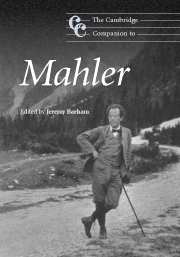Book contents
- Frontmatter
- Introduction: Marginalia on Mahler today
- PART ONE Cultural contexts
- PART TWO Mahler the creative musician
- 4 Juvenilia and early works: from the first song fragments to Das klagende Lied
- 5 Song and symphony (I). Lieder und Gesänge Volume 1, Lieder eines fahrenden Gesellen and the First Symphony: compositional patterns for the future
- 6 Song and song-symphony (I). Des Knaben Wunderhorn and the Second, Third and Fourth Symphonies: music of heaven and earth
- 7 Song and symphony (II). From Wunderhorn to Rückert and the middle-period symphonies: vocal and instrumental works for a new century
- 8 The ‘greatest’ and the ‘most personal’: the Eighth Symphony and Das Lied von der Erde
- 9 The last works
- PART THREE Mahler the re-creative musician
- PART FOUR Reception and performance
- Appendix: selected discography
- Notes
- Bibliography
- Index
6 - Song and song-symphony (I). Des Knaben Wunderhorn and the Second, Third and Fourth Symphonies: music of heaven and earth
from PART TWO - Mahler the creative musician
Published online by Cambridge University Press: 28 September 2011
- Frontmatter
- Introduction: Marginalia on Mahler today
- PART ONE Cultural contexts
- PART TWO Mahler the creative musician
- 4 Juvenilia and early works: from the first song fragments to Das klagende Lied
- 5 Song and symphony (I). Lieder und Gesänge Volume 1, Lieder eines fahrenden Gesellen and the First Symphony: compositional patterns for the future
- 6 Song and song-symphony (I). Des Knaben Wunderhorn and the Second, Third and Fourth Symphonies: music of heaven and earth
- 7 Song and symphony (II). From Wunderhorn to Rückert and the middle-period symphonies: vocal and instrumental works for a new century
- 8 The ‘greatest’ and the ‘most personal’: the Eighth Symphony and Das Lied von der Erde
- 9 The last works
- PART THREE Mahler the re-creative musician
- PART FOUR Reception and performance
- Appendix: selected discography
- Notes
- Bibliography
- Index
Summary
‘Storytelling in song’: Mahler's songs from Des Knaben Wunderhorn
It would scarcely be an exaggeration to suggest that Mahler's compositional ‘genetic code’ can be located in his Lieder output. Many of Mahler's songs show a distinct ambiguity: even the texts of folk songs or children's songs often contain a note of tragedy, farewell, separation or death. Songs on the subject of war or military life, for example, often depict grotesque and disturbing images. It is particularly in the songs of Des Knaben Wunderhorn that Mahler emphasized an unmediated proximity to life, and he was well aware that his choice of texts contrasted sharply with the Lied tradition up to that time. In a letter to Ludwig Karpath from 2 March 1905, Mahler revealed not only his distinct awareness of being the pioneer of a new Lied aesthetic but also his attempts to return to the roots of artistic creativity, and to unveil these as yet untouched by the controlling power of the artistic process – something which is also expressed in his textual additions to the poems. His vivid description of the Wunderhorn texts as ‘blocks of marble’ should be understood in the sense of their being raw or natural materials which first require individual moulding and shaping.
- Type
- Chapter
- Information
- The Cambridge Companion to Mahler , pp. 89 - 107Publisher: Cambridge University PressPrint publication year: 2007



